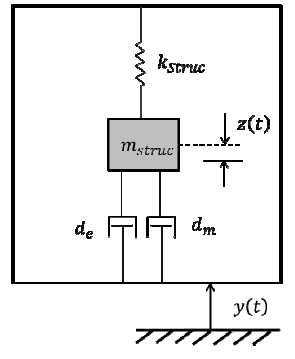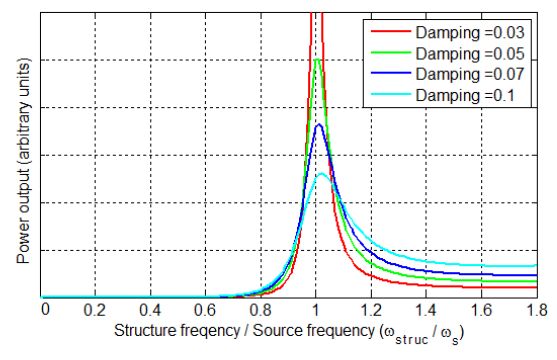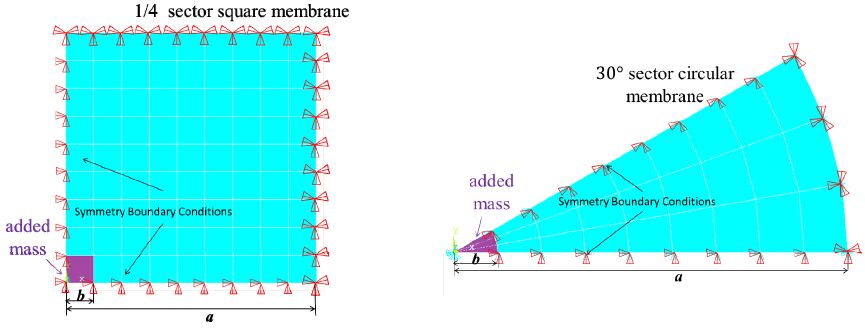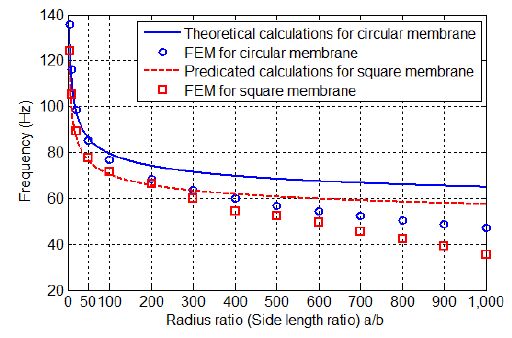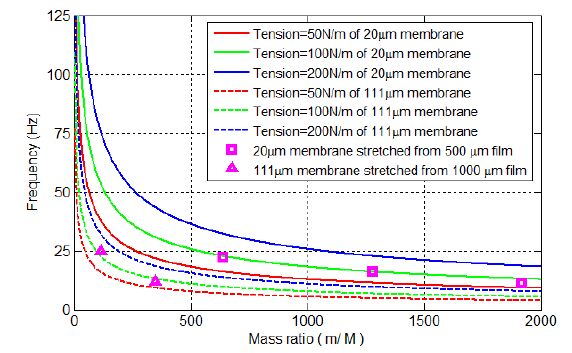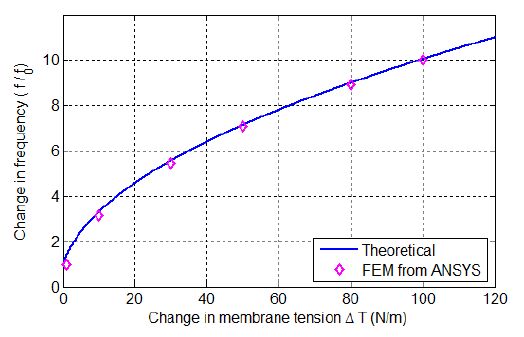Vibration based energy harvesting has been widely investigated to target ambient vibration sources as a means to generate small amounts of electrical energy. While cantilever-based geometries have been pursued frequently in the literature, here membrane-based geometries for the energy harvesting device is considered, with the effects of an added mass and tension on the effective resonant frequency of the membranes studied. An analytical model is developed to describe the vibration response for a circular membrane with added mass structure, with the results closely agreeing with finite element simulation in ANSYS. A complementary study of square membranes loaded with a central mass shows analogous behavior. The analytical model is then used to interpret the experimentally observed shift in resonance frequency of a circular membrane with a proof mass. The impact of membrane tension and central proof mass on the resonant frequency of the membrane suggests that this approach may be used as a tuning method to optimize the response of membrane-based designs for maximum power output for vibration energy harvesting applications.
1.
Introduction
A wide variety of heat-transfer problems applied to Newtonian fluids flow in bounded conduits of cylindrical or parallel-plate geometries with negligible axial conduction has been successfully reduced and known as the Graetz problem [1,2]. Multi-stream or multiphase systems, however, are fundamentally different since conjugated boundary conditions must be coupled at the boundaries, referred to as conjugated Graetz problems [3,4], which were solved analytically by means of an orthogonal expansion technique [5,6] with the eigenfunction expansion in terms of the extended power series. Extension to markedly increased applications of practical processes with recycle-effect concept is possible. It's been widely used in separation, fermentation, and polymerization such as distillation [7], extraction [8], loop reactors [9], air-lift reactor [10], draft-tube bubble column [11], mass exchanger [12], and thermal diffusion column [13].
Many materials of food, polymeric systems, biological process, pulp and paper suspensions [14] with high molecular weight in processing industries exhibit a range of non-Newtonian fluid behavioral features and display shear-thinning and/or shear thickening behavior [15,16]. Those non-Newtonian fluids can be treated as the laminar flow conditions with negligible viscoelastic effects based on their high viscosity levels in the appropriate shear rate range [17]. Therefore, the analytical solution could be analogously obtained under the similar mathematical treatment when dealing with Newtonian fluids. A considerable body of literature has shown the practical feasibility of solving the power-law model of non-Newtonian flows by LBM (Lattice Boltzmann Method). It is also devoted to studying the non-Newtonian behavior with shear-thinning and shear-thickening liquids on sedimentation [18,19] and flows over a heated cylinder [20], an inclined square [21], cylinder [22] and various shapes [23]. Furthermore, the heat-transfer responses to the distributions of the conduit wall and fluid temperature are two major concerns in investigating the heat-transfer efficiency improvement under different kinds of boundary conditions which can be detected at the conduit wall. Two cases of the uniform wall temperature (Dirichlet problem) [24,25] and uniform heat flux (Neumann problem) [26,27] were processed in the application of engineering field, in general. Recently, a non-trivial amount of research use metal foams of PCMs (phase change materials) and nanoparticles of NEPCMs (nano-encapsulated phase change materials) to enhance heat transfer properties in some applications regarding constant heat load, transient, or cyclic loads. Thermal and energy storage managements of crucial importance of systems were investigated within the thermal performance given variable heat loads [28] and non-uniform magnetic sources [29], as well as thermal benefit of NEPCMs nanoparticles in microchannels that considers forced convection [30] and natural convection flow [31,32]. However, the well-known case of sinusoidal wall heat flux distribution [33] of non-uniform heating was the simplest model of period heating within the convective heat-transfer problems in the periodic [34] and circumferentially [35] heating systems. It's been investigated by many researchers to design the cooling tubes in nuclear reactors [36].
The present study is an extension of our previous work [37] to apply the system of non-Newtonian fluids for the conjugated Graetz problem where the power-law index of the shearing-thinning aqueous polymer solutions were given. Though the phenomenon of heat transfer in the present study could be drawn parallel comparison, in similar sense, with that of heat-transfer mechanism in our previous work [37], the manners of non-Newtonian fluids with the convective heat transfer are somehow different. It's actually affected by the velocity profile of shear-thinning fluid. A power-law fluid flowing through a double-pass laminar countercurrent-flow concentric-tube heat exchanger that implemented an impermeable sheet with sinusoidal wall fluxes was investigated for the purpose of examining the heat transfer efficiency and temperature distributions under external recycling, which was solve analytically through the resultant conjugated partial differential equations by the superposition technique. The recycle ratio and impermeable-sheet position are two parameters treated as essential and should be suitably adjusted to an improved design of heat transfer equipment. The comparison of heat-transfer efficiency improvement and Nusselt numbers in both operations (single- and double-pass device) is also discussed.
2.
Dimensionless temperature distributions
A double-pass concentric circular heat exchanger was made by inserting an impermeable sheet into a circular tube of inside diameter 2R and length L, as shown in Figure 1. The thickness of the inner (subchannel a) and annular tube (subchannel b) are 2κR and 2(1-κ)R, respectively. Comparing with the radius of outer circular tube R and outer circular tube R1, the thickness of the impermeable barrier δ is negligible (δ << R). Two flow patterns, flow pattern A and flow pattern B, are proposed by and used in this study. An inlet fluid with volumetric flow rate V and temperature T1 will enter the subchannel a and then flows reversely into the subchannel b with the aid of a convectional pump at the end of the conduit like flow pattern A, as shown in Figure 1(a). On the other hand, the flow pattern B is that the fluid feeds into subchannel b and exits from the subchannel a, as shown in Figure 1(b). The fluid is heated by the outer wall with sinusoidal heat fluxes, $ {q}_{w}^{″}\left(z\right) = {q}_{0}^{″}\left[1+\mathit{sin}(\beta z)\right] $ in both flow patterns.
The problem of laminar heat transfer at steady state with negligible axial conduction was known as the Graetz problem, and the convective velocity in radial direction is neglected by applying the Navier-stokes relations to obtain the hydro-dynamical equation for laminar flow. The energy balance equations of fluid flowing in the subchannel a and subchannel b in dimensional form with specified velocities are:
The theoretical analysis of double-pass heat exchangers is developed based on the following assumptions: (a) constant physical properties of fluid; (b) fully-developed laminar flow with power law index $ \omega $ ($ \tau = -c{\dot{\gamma }}^{\omega } $) in each subchannel; (c) neglecting the entrance length and the end effects; (d) ignoring the longitudinal heat conduction and the thermal resistance of the impermeable sheet; (e) well mixed at both inlet and outlet. With these assumptions, the dimensionless energy balance equations and the velocity distributions of a double-pass heat exchanger with sinusoidal heat fluxes were formulated by neglecting the second terms on the right-hand side of Eq. (1) and Eq. (2). The descriptions of two or more contiguous streams of multi-stream (or phases of multi-phase) problems with coupling mutual boundary conditions [38,39] becomes
where $ {v}_{a} $ and $ {v}_{b} $ are the velocity distributions in subchannels a and b, respectively, as follows in flow pattern A:
and in flow pattern B:
The values of $ \beta $ ($ {v}_{b}\left(\beta \right) = {v}_{b, max} $) in Eq. (6) and Eq. (7) for flow pattern A, and Eq. (9) and Eq. (10) for flow pattern B, were obtained via the given $ \omega $ and $ \kappa $, as shown in Table 1 [40]. The terms with the power law index $ \omega $ on the right-hand side of Eq. (5) and Eq. (6) and (7) for flow pattern A (Eq. (9) and (10) for flow pattern B), respectively, were approximated using the polynomials fitted at the selected points for the acceptable tolerance as follows:
The coefficients were obtained with the given power law index $ \omega = 0.6 $ as an illustration, shown in Table 2.
The corresponding boundary conditions are:
in which
The general form of dimensionless temperature distributions of the laminar double-pass countercurrent-flow concentric tube heat exchangers with sinusoidal wall fluxes can be expressed as follows [41]:
in which the $ {\theta }_{\text{0a}} $ and $ {\theta }_{\text{0b}} $ are the constants yet to be determined, and the $ {\theta }_{\text{1a}}\left(\eta \right) , {\theta }_{2a}\left(\eta \right) , {\theta }_{3a}\left(\eta \right) , {\theta }_{\text{1b}}\left(\eta \right) , {\theta }_{2b}\left(\eta \right) $ and $ {\theta }_{3b}\left(\eta \right) $ are the functions of $ \eta $ to be determined.
Substituting Eqs. (18) and (19) into the governing equations, Eqs. (3) and (4), and the boundary conditions, Eqs. (13)–(16), yields
2.1. Solving $ {\theta }_{2a}\left(\eta \right) , {\theta }_{3a}\left(\eta \right) , {\theta }_{2b}\left(\eta \right) $ and $ {\theta }_{3b}\left(\eta \right) $by using Frobenius method
Multiplying Eqs. (20)–(25) by $ \mathit{sin}(B\xi) $ and integrating with respect to ζ in the interval [0, 2π/B] gives:
Similarly, multiplying Eqs. (20)–(25) by $ \mathit{cos}(B\xi) $ and integrating with respect to ζ in the interval [0, 2π//B], one can obtain:
The complex functions $ {\psi }_{a}\left(\eta \right) = {\theta }_{2a}\left(\eta \right)+{\theta }_{3a}\left(\eta \right)i $ and $ {\psi }_{b}\left(\eta \right) = {\theta }_{2b}\left(\eta \right)+{\theta }_{3b}\left(\eta \right)i $ were introduced to combine Eqs. (26)–(31) and Eqs. (32)–(37) into a unique one-dimensional boundary value problem according to the prior mathematical treatment [41] as follows:
We can apply the method of Frobenius which enables one to create a power series solution to solve differential equations. Assuming $ {\psi }_{a}\left(\eta \right) $ and $ {\psi }_{b}\left(\eta \right) $ have the forms of power series multiplied by unknown powers of $ \eta $, respectively, leads to:
One can find the constants of $ {r}_{a} $ and $ {r}_{b} $ are proved to be zero in this system equations. The coefficients $ {a}_{n} $ and $ {b}_{n} $ are determined by solving Eqs. (38) and (39) and incorporating the boundary conditions of Eqs. (40) to (43), and then comparing with the real and imaginary parts of the complex functions $ {\psi }_{a}\left(\eta \right) = {\theta }_{2a}\left(\eta \right)+{\theta }_{3a}\left(\eta \right)i $ and $ {\psi }_{b}\left(\eta \right) = {\theta }_{2b}\left(\eta \right)+{\theta }_{3b}\left(\eta \right)i $, and thus the recursive relations were obtained for flow pattern A, respectively, as follows:
and
Similarly, the recursive relations of the coefficients $ {a}_{n} $ and $ {b}_{n} $ for flow pattern B are
and
2.2. Solving $ {\theta }_{0a} , {\theta }_{1a}\left(\eta \right) , {\theta }_{0b} $ and $ {\theta }_{1b}\left(\eta \right) $ by double integrations
Integrations of Eqs. (20) to (25) with respect to $ \xi $ in the interval [0, $ 2\pi /B $], one can obtain
Furthermore, integrating Eqs. (50) and (51) twice with respect to $ \eta $ for $ {\theta }_{1a}\left(\eta \right) $ and $ {\theta }_{1b}\left(\eta \right) $, respectively, yields
and
where $ {\gamma }_{1a} , {\gamma }_{2a} , {\gamma }_{1b} $ and $ {\gamma }_{2b} $ are the integrating constants in Eqs. (57) and (58). Since there are six constants ($ {\theta }_{0a} , {\theta }_{0b} , {\gamma }_{1a} , {\gamma }_{2a} , {\gamma }_{1b} $ and $ {\gamma }_{2b} $) to be determined given five equations (Eqs. (52) to (56)), it needs one extra equation. The additional one equation of the overall energy balance is required as follows:
Eq. (59) can be rewritten as
where the $ {\varphi }_{F} $ is the average outlet temperature and it is defined as
in flow pattern A, and
in flow pattern B. Further, Eqs. (61) and (62) should be solved by using Eqs. (6), (7) and (19) and Eqs. (8) and (18) at $ \xi = 0 $, respectively. Therefore, the complete solutions of dimensionless temperature distributions in a double-pass concentric circular heat exchanger were obtained by substituting the functions of $ {\theta }_{1a} , {\theta }_{1b} , {\theta }_{2a} , {\theta }_{2b} , {\theta }_{3a} $ and $ {\theta }_{3b} $, and constants of $ {\theta }_{0a} $ and $ {\theta }_{0b} $ into the $ {\varphi }_{a} $ and $ {\varphi }_{b} $ (say Eqs. (18) and (19)).
3.
Heat-transfer efficiency enhancement
The local Nusselt number is usually used to measure the convection heat transfer occurring at the wall surface of double-pass concentric circular heat exchangers in forced convection heat-transfer problems and defined as
where k is the heat conductivity coefficient of the fluid, $ De $ is the equivalent diameter of the conduit, $ De = 2R $, and h is the heat transfer coefficient. The heat-transfer coefficient h is defined as
or, in the dimensionless form
Substituting Eq. (65) into Eq. (63) yields
Similarly, the local Nusselt number of single-pass heat exchangers is defined as
where the wall temperature distribution, $ {\varphi }_{0}\left(1, \xi \right) $, of single-pass heat exchangers can be determined, according to the reference [41].
Moreover, the average Nusselt numbers of single- and double-pass concentric circular heat exchangers, respectively, were determined by
and
The heat-transfer efficiency enhancement was illustrated by calculating the percentage increase in the device by employing a double-pass operation, based on single-pass device with the same working dimensions and operating parameters
4.
Power consumption increment
The power consumption increment is unavoidable due to inserting an impermeable sheet into a single-pass device to conduct double-pass operations. The power consumption only incurring the friction losses to walls in double-pass operation were significant. And relations to joint, diversion or bending of conduit are neglected for simplicity. It may be obtained by using generalized Bernoulli equation [42] with following assumptions: (a) incompressible fluid; (b) no change in average velocity; (c) no change in elevation; (d) no work performed. Hence, the power consumption may determine using Fanning friction factor $ {f}_{F} $ [43]:
The relative extents $ {I}_{P} $of power consumption increment was illustrated by calculating the percentage increment in the double-pass operation, based on the single-pass device as
5.
Results and discussions
The applications of Frobenius method to solve for differential equations are expanded in terms of an extended power series, say Eqs. (38) and (39). To illustrate, comparison is made to such a power series with terms truncated after $ n = 70 $ and $ n = 75 $ with $ \kappa = 0.5 $ and $ \omega = 0.8 $. The accuracy of those comparisons is analyzed and some results are presented in Table 3 for an extended power series for flow pattern A. It can be observed from Table 3 that the power series agree reasonably well with the term of $ n = 70 $, and hence those power series with $ n = 70 $ are employed in the calculation procedure.
The dimensionless temperature distributions of power-law fluids in double-pass concentric circular heat exchanger with sinusoidal wall flux are obtained through solving the energy balance equations with the aid of the linear superposition method. Obtaining the wall temperature distributions in advance of the design of the heat exchanger equipment is important for an engineer to select the appropriate materials and to carefully consider both technical and economic feasibility. It can be observed in Figure 2 for the flow pattern A that the wall temperature is getting lower at the downstream in subchannel b. The wall temperature at the whole part of subchannel b could reach an extremely low value, especially for remarkably high flow rate, say $ Gz $ = 100. On the contrary, the wall temperature is getting higher at the downstream in subchannel b for the flow pattern B. The wall temperature profiles are growing up toward the end downstream, as shown in Figure 3 for the flow pattern B. The wall temperatures are found to be close to the inlet temperature at the flow entrance irrespective of the $ Gz $ values. The wall temperature becomes a little bit lower for smaller $ \omega $ (more apparently shear-thinning), regardless of the flow pattern. It is noteworthy that the wall temperatures are monotonically increasing or decreasing along the heat-exchanger device even with the sinusoidal wall heat flux. Regarding the device performance, the simulated Nusselt number Nu is demonstrated in Figure 4, and both flow patterns of the double-pass concentric circular heat exchanger show much more effective energy transfer than that from the single-pass device. The performance of device is further improved along with the increasing $ Gz $. The device with the flow pattern B is shown to be more effective than that of the flow pattern A and single-pass operations under the same $ \omega $ condtion. For both flow patterns, the Nu is getting lower with the smaller $ \omega $.
The dimensionless wall temperatures are demonstrated in Figures 5 and 6 for the flow patterns A and B, respectively, to illustrate the influence of $ \kappa $value (impermeable-sheet position). The wall temperature shows monotonically decreasing tendency for flow pattern A and increasing tendency for flow pattern B. On the other hand, the wall temperature presented longitudinal fluctuations in accordance with the sinusoidal wall flux. It is also found that the wall temperature increases with small $ \kappa $ (relative larger thickness of subchannel b) and decrease with a higher $ Gz $ for both flow patterns.
In Figure 7, it is found that the Nusselt number Nu of the current double-pass heat exchanger is sensitive to the $ \kappa $ values. The Nusselt number Nu increases with the $ \kappa $ values which indicated the double-pass device with a narrower subchannel b could accomplish better heat-transfer efficiency. It is also found the device of flow pattern B could have better device performance improvement than that of flow pattern A.
When simultaneously considering the heat-transfer improvement enhancement $ {I}_{h} $ and the power consumption increment $ {I}_{p} $, its ratio $ {I}_{h}/{I}_{p} $ is plotted versus Graetz number $ Gz $ with the $ \kappa $ value as a parameter in Figure 8 and Tables 4 and 5. The ratio of $ {I}_{h}/{I}_{p} $ rapidly increases with $ Gz $ and quickly flatten out. It also rises with the increase in $ \kappa $. The double-pass device of flow pattern B demonstrated to be more beneficial in economic sense than that of flow pattern A.
6.
Conclusions
A mathematical formulation for a concentric circular double-pass heat exchanger of power-law fluids with sinusoidal wall flux has been formulated, and the analytical solution is obtained using orthogonal expansion technique. The double-pass flow patterns can be achieved by inserting an impermeable sheet into a cylindrical heat exchanger to examine the heat transfer behavior. The double-pass device performance can be significantly enhanced when compared to that of the single-pass one, especially for a narrower annular flow channel (subchannel b). The average Nusselt number of the device of flow pattern B (annular flow in, core flow out) is larger than that of flow pattern A (core flow in, annular flow out). The longitudinal wall temperature profile is able to be more smoothing despite the sinusoidal wall flux. The wall temperature is decreasing in longitudinal direction for flow pattern A and increasing for flow pattern B, and the variations are much more moderate for high flow rates, for example at $ Gz $ = 100. A comparison is also made for the heat-transfer improvement enhancement $ {I}_{h} $ and the power consumption increment $ {I}_{p} $ in the form of $ {I}_{h}/{I}_{p} $. One could find that the flow pattern B always performs better than that of flow pattern A when assessing the economic feasibility of both the flow patterns A and B by ratio $ {I}_{h}/{I}_{p} $.
Acknowledgments
The authors wish to thank the Ministry of Science and Technology (MOST) of the Republic of China for its financial support.
Conflict of interest
The authors have no conflict of interest.
Supplementary
Nomenclature
Subscripts










 DownLoad:
DownLoad:












